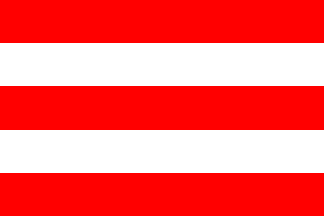
by António Martins, 28 Febuary 2001

Last modified: 2005-05-28 by dov gutterman
Keywords: hungary | csongrad |
Links: FOTW homepage |
search |
disclaimer and copyright |
write us |
mirrors
See also:

by António Martins, 28 Febuary 2001
This flag (Five red and white horizontal stripes) appears at
Dr. Széll Sándor: Városaink neve, címere és lobogója (1941)
as "Csongrád, Csongrád Co. ".
István Molnár, 20 October 2000 and António Martins,
28 Febuary 2001
cs_cs.gif)
Coat of Arms
by Jorge Candeias, 8 May 2005
Source: A magyar városok címerei (Coat of Arms of
the Hungarian cities and towns); 1975.
István Molnár
cs-cs.gif)
from <www.csongrad.hu>,
located by Dov Gutterman , 3 March 2000
From <www.csongrad.hu>:
The town of Csongrád is located in the Central Tisza region,
opposite the mouth of the Hármas-Körös.
The coat-of-arms is a shield erect, the base curved to a point.
It bears: azure, a triple-branched demi rose issuant from a heart
gules, the middle stem bearing three leaves, the dexter and the
sinister stems two leaves each, and all the three topped with a
blossoming bloom. One bloom is borne in bend, one in bend
sinister, whereas the middle one is borne palewise with a dove
argent perched thereon.
Across the top a mural crown with a battlement of five merlons
or. Mantling: floral ornament (acanthus leaves) gules and or on
both sides.
The archetype of the blazonry of this coat-of-arms appeared on
the town's seal made in 1738. This seal was used until 1849, and
then again between 1903 and 1949. The present version has been in
use since 1990.
The blue field evokes the town's rives, its old ferry, the
one-time fishing and crab-catching, as well as the traditional
handicraft industry (i.e. the making of objects from reed and
sedge).
The heart with the roses issuing therefrom is a very old symbol,
appearing frequently in our folk traditions and early linguistic
records as the representation of love, relatedness, of being
worried about others and of making sacrifices for them. All this
becomes the people of Csongrád, as proven by Gedehalom, the tomb
of the "Avar Romeo and Juliet", and the firmness shown
in the fights for independence.
The blooming rose on the one hand expresses that the settlement
has permanently been inhabited since the Neolithic age up to the
present day, while the other hand it symbolizes that despite
repeated destruction, Csongrád always revived and prospered with
an unbroken will to live. In addition, the rose also means that
the local people were always ready to make sacrifices for God,
their homeland and the King.
The seven rose petals are the reminders of our ancestors who
conquered this land. One of them was the chief Ond, whose son Ete
gathered many Slavs and, according to the chroncler Anonymus,
'had a very strong earthwork built, which the Slavs called in
their language Csongrád, that is black castle'.
The dove symbolizes the family, the local community and the
abundance that arises from it. In addition, since the dove looks
to the dexter side, it may also express faith in the future.
According to biblical tradition, Noah's dove is the example of
reconciliation, peacefulness and the relatedness of honest
people.
The mural crown with the five merlons is a reminder of the fact
that King St Stephen had a castle built and the seat of a comitat
established here, which existed until the Mongol invasion of
1241-2. Following this, the settlement was owned by the castle of
Szeged, and later by great landlords. As one of then was the
Hunyadi family (since 1456), some presume that the seal of 1738
is fallacious, because the original charge would have been the
raven [Turkish administrative unit] of Szeged, then that of
Szolnok. After 1686 it became a market town.
The red mantling on the one hand suggests that folk traditions
are being cherished (this is also expressed by the charge
itself), while on the other hand, as the 'inn sign' of the
excellent local red wine, it refers to the wine festivals and to
the cult of St Vincent, patron saint of vineyardists.
The golden mantling evokes the rich soil around Csongrád and the
hard work of its inhabitants.
Csongrád's coat-of-arms is a fine example of how the concept of
progress based on traditions can be represented, thus also
conveys a message to the people of today.
István Molnár, 3 March 2001